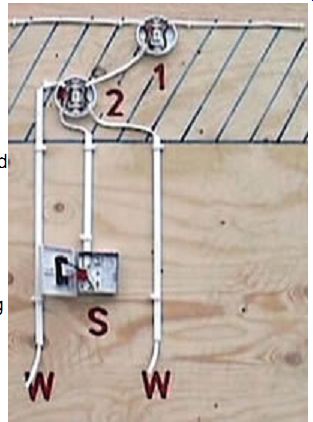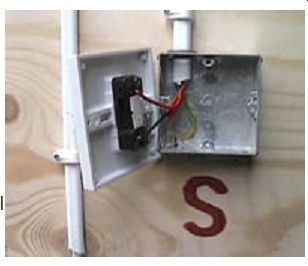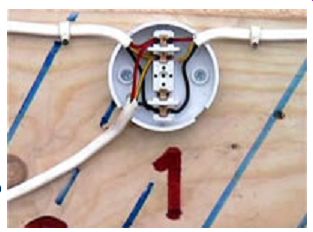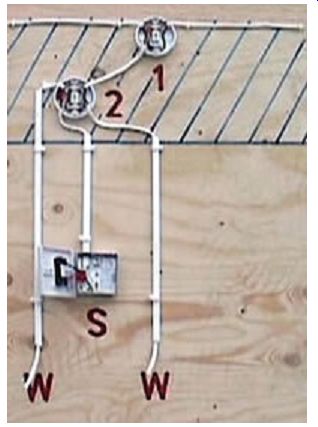light switch, dimmer
Welcome to our Electrical Project: WIRING IN SWITCHED WALL LIGHTS
"How can I introduce another light or lights into my room switched independently of my main light".
Please remember when attempting any electrical installations at home that you are obliged to get the completed job tested by a fully qualified electrician and obtain a minor works certificate. Failure to do this may render your house insurance invalid and you may have difficulty selling your home. As with our bathroom project, we believe in realism and although we didn't have a specific contract to carry out this operation, we have made up a circuit board, using the actual fittings, for you to view. Our project shows 2 wall lights added, but the same circuit can be used for an additional ceiling light switched independently.
You will need:
• 1 x 20 amp junction box (3 terminal)
• 1 x 20amp junction box (4 terminal)
• 1 x 1 way switch
• 1 x single pattress box with grommet.
• 1.5mm cable to suit. (click, and see rules)
• Earth sleeve........Red tape
• Cable clips..........Screws
• Wall conduit for 1.5mm cable.
• We have used 20amp junction boxes to allow more room.

STEP 1. (Do not cut or remove any cables or wires without first turning your power off and removing the fuse from the circuit you are working on. If working with "trip switches" put a large note on the consumer unit. You may have turned the power off and be in the loft, when an unknowing family member thinks the lights have tripped and flicks the switch..!) Think carefully about the position of your new light/s and mark the wall, make your holes and chases, and all new connections before making the final connections to the existing circuit. That way you can keep the lights on as long as possible.
Trace a lighting cable from the light point nearest to the position of your new light/s. (do not disconnect or cut anything yet) You need a cable that does not go to a switch. Make sure you have enough slack on your chosen cable to insert a junction box and be able to fix it securely to a joist or rafter. You may have to insert a timber "noggin" to achieve this fixing. You need to work out where this position is, in relation to the position you will install your new cables according to the circuit you choose.
For this example you will need to mark the wall for your switch, and both wall lights. Make a hole large enough in the wall to accept the switch box (pattress), mark and chase a slot in the wall wide enough to accept your cable and its conduit container. Take this chase up the wall to the ceiling and make a hole in the ceiling at the back of the chase. (when the chase is filled you will not see the hole). Make the same chase and hole for the wires to the wall lights.
Take out a "blanking piece" from the pattress box and insert a rubber grommet to stop the cable chafing the metal.
Connect the box securely to the wall using the holes provided. Take a length of 1.5mm cable and run it from the cable you have identified earlier, through the hole in the ceiling and down to a) switch b) both wall lights. Allow sufficient cable for your connections at each end.

Thread the lower end of these cables into suitable conduit, so the top end of the conduit just goes through your ceiling or floor and the bottom end finishes at the end of the chase. Fix this conduit to the back of the chase. We have used cable clips in this diagram, but you could use anything that will not rust to hold them in place until you have plastered.

Now strip the switch wires, connecting the earth to the earthing point in the pattress box, the red to the top terminal of the switch, and the black, after applying a piece of red tape, to the bottom terminal. Screw the switch plate on the pattress box.
Connect your wall lights to manufacturers instructions.
Now we will be working on the level above, if you are in the loft, rig yourself up a suitable lead light which you will be able to plug into an ordinary socket. This will still work when you switch of the lighting circuit. It is as well to do this now to avoid too many trips up and down. Turn off the power and remove the fuse.
Strip the ends of both wall light cables and fix them into a 4 terminal, 15 amp junction box.
Leave an end terminal free and join both lives (red) in the other end terminal, then both earths, then both neutrals (black). The earth wire will need a small piece of earth sleeving over it. Fix this junction box securely to a joist or rafter.
Take a length of cable and strip the wires from both ends, join the red (live) to the spare terminal you have left in the first junction box.

The earth and neutral go to join the other earths and neutrals in that same box. The other end of this cable will go to the existing circuit in a moment. Now take the end of the switch wire and strip. Join the red to the single red in what was the spare terminal, and the black (after applying a piece of red tape), to the other reds from your wall lights. This off course means that both the black and red wires to the switch are live, and you have interrupted the live flow with the switch, which when on, will complete the circuit.
[Left] Line drawing of circuitry photo 2.
The top right cable is the one which will go to the existing. Top left is a wall light cable. Bottom left goes to the switch. Bottom right to the second wall light.
Now its time to connect up. Make absolutely sure your lighting circuit is dead and cut the cable you first identified.

Strip the ends of all the wires, apply earthing sleeves and join them up again in the junction box, while at the same time including the wires from the cable in between the two junction boxes. Red to red, black to black and earth to earth. Keep the earth wires in one of the middle terminals and the red and black as far apart as possible in the far two terminals.
Top cables are existing, cut and joined. Bottom cable goes to second junction box.
Your complete circuit should look like this...only a bit more spread out !

The blue shaded area is your loft, or floor void, W = wall-lights & S = switch.
Now run through each connection, check it, fit the covers on junction boxes, insert the fuse and switch on. Complete the plaster-work before making a live connection, and make sure it is dry before you do. Or check everything is working then turn it all off again to do the plasterwork waiting until dry to turn on again.
---------